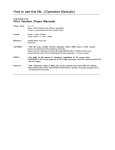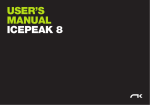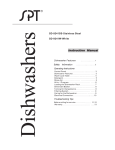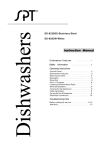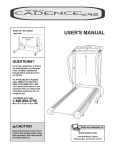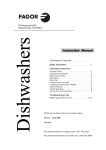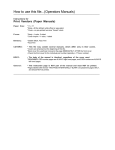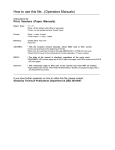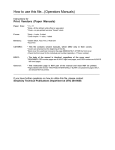Download Simplicity 1693847 Operator`s manual
Transcript
How to use this file...(Operators Manuals) ————————————————————————————————————————————––– Instructions for Print Vendors (Paper Manuals) Paper Size: * 11 x 17 * Body—50 lbs brilliant white offset or equivalent. * Cover—on pre-printed two-tone “Swash” stock. Press: * Body—1-color, 2-sided * Cover imprint —1-color, 1-sided Bindery: * Saddle Stitch, Face Trim * Face Trim COVERS: * This file may contain several manuals, which differ only in their covers. * Covers are all present at the beginning of this file. * Back cover for a particular manual is the page IMMEDIATELY AFTER the front cover. • Check the front cover for the individual part number (typically a 171xxxx number). BODY: • The body of the manual is identical, regardless of the cover used. * REMEMBER: ODD number pages are ALWAYS right hand pages, and EVEN number are ALWAYS left hand pages. General: * This instruction page is NOT part of the manual and must NOT be printed. • Pages labeled with the text “THIS PAGE INTENTIONALLY BLANK” are placement pages ONLY, and should NOT be printed. ————————————————————————————————————————————––– THIS PAGE INTENTIONALLY BLANK OPERATOR’S MANUAL Rear Tine Tiller 5.5HP Rear Tine Tiller Mfg. No. 1693847 Description 5HP Rear Tine Tiller 6.5HP Rear Tine Tiller Mfg. No. 1693848 Description 6HP Rear Tine Tiller 1721526-00 Rev 1/2001 TP 100-2485-00-RT-S MANUFACTURING, INC. 500 N Spring Street / PO Box 997 Port Washington, WI 53074-0997 www.simplicitymfg.com © Copyright 2001 Simplicity Manufacturing, Inc. All Rights Reserved. Printed in USA. Table Of Contents TABLE OF CONTENTS ......................................... 1 OPERA TION SAFETY ........................................... 2 OPERATION Owner's Responsibility ............................................. 2 Cautions and Important Notes .................................. 2 Important Safety Instructions .................................... 2 SAFETY SIGNS & DECALS .................................. 4 Safety Decals ........................................................... 4 FEA TURES ........................................................... 5 FEATURES CONTR OLS .......................................................... 6 CONTROLS Drive Safety Control Levers ...................................... 6 Reverse Handle ........................................................ 7 Engine Controls ........................................................ 8 ADJUSTMENTS .................................................... 9 Wheel Lockouts ........................................................ 9 Handlebar Height Adjustment ................................. 10 Depth Regulator Lever ........................................... 11 Belt Tension Adjustment ......................................... 12 OPERA TION ....................................................... 13 OPERATION Pre-Start Inspection ............................................... 13 Starting and Stopping the Engine ........................... 13 Tilling ...................................................................... 14 TIPS .................................................................... 15 Tilling Tips .............................................................. 15 Cultivating Tips ....................................................... 15 MAINTENANCE AND ST ORA GE ......................... 16 STORA ORAGE Check Forward Belt Tension ................................... 16 Check Reverse Belt Tension ................................... 16 Change Forward/Reverse Belt ................................ 17 Check or Fill Engine Crankcase ............................. 18 Check Tiller Transmission Grease .......................... 19 Check Tire Pressure ............................................... 19 Lubrication .............................................................. 19 Clean Tine Axle Shaft ............................................. 19 Engine Maintenance ............................................... 20 Prepare for Storage ................................................ 21 Tiller and Engine Maintenance Schedule ............... 21 TR OUBLESHOO TING AND REP AIR ................... 22 TROUBLESHOO OUBLESHOOTING REPAIR Troubleshooting Guide ............................................ 22 SPECIFICA TIONS ............................................... 24 SPECIFICATIONS Features ................................................................. 24 Technical Manual Availability .................................. 24 For easy ref erence reference erence,, please record the w. inf or mation on the char infor ormation chartt belo below CAUTION You must read, understand and comply with all safety and operating instructions in this manual before attempting to setup and operate this equipment. Failure to comply with all safety and operating instructions can result in loss of machine control, serious personal injury to you and/or bystanders, and risk of equipment and property damage. The triangle in the text signifies important cautions or warnings which must be followed. The Rototiller Reference Data can be found on the identification tag located on the unit's left engine mount. (Refer to the Engine Owner's Manual for location of engine information serial number.) ROTOTILLER REFERENCE DATA Model Description/Number M/N (Manufacturer's Number) S/N (Serial Number) Dealer Name Date Purchased CAUTION Engine exhaust from this product contains chemicals known, in certain quantities, to cause cancer, birth defects, or other reproductive harm. ENGINE REFERENCE DATA Engine Make/Model Page 1 Engine ID/Serial Number Operation Safety SECTION CHECKLIST IMPOR TANT SAFETY INSTR UCTIONS IMPORT INSTRUCTIONS Owner's Responsibility GENERAL Cautions and Important Notes Y READ THIS MANU AL AND • CAREFULL CAREFULLY MANUAL FOLLO W ALL INSTR UCTIONS FOLLOW INSTRUCTIONS UCTIONS.. Important Safety Instructions • Be familiar with all controls before operating the tiller. Your tiller is equipped with a safety device that enables you to stop the wheels and tines quickly in an emergency. Learn how the drive safety control levers work and how to control the tiller at all times. • Never allow children to operate the tiller. Keep small children away from the area being tilled. Do not allow adults to operate the tiller without proper instruction. OWNER'S RESPONSIBILITY Safe and effective use of the rototiller is the owner's responsibility. 1. Read and follow all safety instructions. 2. Maintain the tiller according to directions and schedule included. 3. Ensure that anyone who uses the tiller is familiar with all controls and safety precautions. CA UTIONS AND IMPOR TANT NO TES CAUTIONS IMPORT NOTES Two symbols which draw attention to information of special importance appear throughout this manual. These comments range in importance from helpful hints to warnings about risk of personal injury. Please take the time to read and understand them. The right and left sides of your rototiller are determined from the operating position as you face the direction of forward travel. PREPARATION • Dress appropriately when operating the tiller. Always wear sturdy footwear. Never wear sandals, sneakers, or open shoes, and never operate the tiller with bare feet. Do not wear loose clothing that might get caught in moving parts. • Carefully inspect the area to be tilled, and remove all foreign objects. Do not till above underground water lines, gas lines, electric cables, or pipes. Do not operate the tiller in soil with large rocks and foreign objects which can damage the equipment. • Disengage all clutches and shift into neutral before starting the engine. • Handle fuel with care; it is highly flammable. a. Use an approved fuel container. b. Never add fuel to a running engine or hot engine. c. Fill fuel tank outdoors with extreme care. Never fill fuel tank indoors. d. Replace gasoline cap securely and clean up spilled fuel before restarting. • Never attempt to make any adjustments while the engine is running. may Indicates a situation which ma y cause personal alert! injury injur y. It means - attention! Become aler t! Your safety inv olved. saf ety is in volv ed. Provides infor ormation Pro vides helpful inf or mation ffor or proper assembly ly,, oper operation, assemb ly ation, or maintenance of yyour our rototiller.. rototiller Please read this section carefully carefully.. Operate the tiller according to the safety instructions and recommendations outlined here and inserted throughout the text. Make sure anyone who uses the tiller has read the instructions and is familiar with the controls. Page 2 Operation Safety OPERA TION OPERATION • Never allow bystanders near the unit. • Never operate the tiller without guards, covers, and hoods in place. • Use only attachments and accessories approved by the manufacturer of the tiller. • Never start the engine or operate the tiller with the wheels in the free-wheel position. Make sure the wheel lockouts or lockpins are engaged through wheel hubs and wheel axle. The wheels act as a brake to keep the tiller at a controlled speed. Disengage wheels to permit free-wheeling only when engine is stopped. • Never operate the tiller without good visibility or light. • Be careful when tilling in hard ground. The tines may catch in the ground and propel the tiller forward. If this occurs, let go of the handlebars and do not restrain the machine. • Take all possible precautions when leaving the machine unattended. Disengage all controls levers, stop the engine, wait for all moving parts to stop, and make certain guards and shields are in place. • When leaving the operating position for any reason: - shut off the engine. - wait for all moving parts to stop. • Keep hands, feet, and clothing away from rotating parts. Keep clear of tiller tines at all times. • Tines and wheels rotate when tiller is engaged in orward rev orward forw ard or re verse-- in forw ard, tines and wheels rotate when the drive safety control levers are pulled down; in re rev verse, wheels and tines rotate when the reverse handle is pulled back towards the operator. Releasing the drive safety control levers to neutr neutral al stops the wheels and tines. • Be extremely cautious when operating in re rev verse. Take extra care to avoid slipping or falling, and to keep feet clear of tines. • Exercise extreme caution when operating on or crossing gravel drives, walks, or roads. Stay alert for hidden hazards or traffic. • After striking a foreign object, stop the engine, remove the wire from the spark plug, thoroughly inspect the tiller for any damage, and repair the damage before restarting and operating the tiller. • If vegetation clogs the tines, raise the handlebars to elevate the tines, and run the tiller in re rev verse. If this does not clean clogged vegetation from the tines, ST OP THE ENGINE AND DISCONNECT THE STOP SP ARK PLUG WIRE before removing vegetation SPARK by hand. • Engine muffler will be hot from operation. Do not touch it with bare skin or a severe burn may result. MAINTENANCE AND STORAGE • Keep machine, attachments, and accessories in safe working condition. • Check shear bolts, engine mounting bolts, and other bolts at frequent intervals for proper tightness to be sure the equipment is in safe working condition. • To prevent accidental starting, always disconnect and secure the spark plug wire from the spark plug before performing tiller maintenance. • Never run the engine indoors. Exhaust fumes are deadly. • Always allow muffler to cool before filling fuel tank. • Never store equipment with gasoline in the tank inside a closed building where fumes may reach an open flame or spark. Allow the engine to cool before storing in any building. • Always refer to the operator's guide instructions for important details if the tiller is to be stored for an extended period. • If the unit should start to vibrate abnormally, stop the engine and check immediately for the cause. Vibration is generally a warning of trouble. • Do not run the engine indoors; exhaust fumes are dangerous. • Do not overload the machine capacity by attempting to till too deep at too fast a rate. • Never operate the machine at high transport speeds on slippery surfaces. Look behind and use care when backing. Page 3 Safety Signs & Decals SAFETY DECALS Safety warning decals are placed at strategic locations on the equipment as a constant reminder to the operator of the most important precautions. All warning, caution and instructional messages on your equipment should be carefully read and obeyed. If any of these decals are lost or damaged, replace them at once. They can be purchased from your local dealer. Par artt No No.. 1716747 OPERA TING INSTR UCTIONS / Hood Decal OPERATING INSTRUCTIONS Par artt No No.. 1716840 TINES D ANGER / Hood Flap Decal DANGER Par artt No No.. 1716800 WARNING / Belt Co ver Decal Cov Par artt No No.. 1716839 FREE HAND / Bumper Guard Decal Page 4 Features MODEL 6516R TB* 6516RTB* Drive Safety Control Lever Reverse Handle Console Reverse Belt Tension Adjustment Forward Belt Tension Adjustment Engine Controls Drag Stake Detent Pin Belt Cover Wheel Lockouts (Standard on Model 6516RTB) Bumper Guard (Standard on Model 6516RTB) Serial No. Plate * Hiller-Furrower Attachment is standard on Model 6516RTB. Page 5 Controls SECTION CHECKLIST CAUTION Drive Safety Control Levers Reverse Handle Engine Controls DRIVE SAFETY CONTR OL LEVERS CONTROL This information is provided here only to introduce the controls. DO NOT START THE ENGINE AT THIS TIME. Starting and operating instructions are given on page 13. Please read this section and all operating and safety instructions before starting your tiller. Engage wheels and tines into forward, releasing returns machine to neutral. Pulling down on drive safety control levers engages the wheels and tines. Releasing drive safety control levers disengages the wheels and brings the tiller to a complete stop. It is now in the neutral position. CAUTION ENGINE SHOULD BE OFF BEFORE ADJUSTING ANY CONTROLS! Drive Safety Control Levers Engaged ❖ As a safety precaution, the drive safety control levers will not lock in the forward position. ❖ To stop the wheels and tines at any time release the drive safety control levers. Page 6 Controls REVERSE HANDLE Engages wheels and tines in reverse. Pulling reverse handle back towards operator reverses tiller. CAUTION Extreme caution should be used when operating rototiller in the reverse direction. reverse handle ❖ As a safety precaution, the reverse handle will not lock in reverse. ❖ To stop the wheels and tines at any time, release the reverse handle. ❖ Do not operate both the reverse handle and drive safety control levers at the same time. Page 7 Controls ENGINE CONTR OLS CONTROLS Throttle Control Move throttle control to fast position to start and run the engine. To stop the engine, move to idle position, then to off. Choke Chok e Control Put choke control in choke position if engine is cold. A warm engine requires less choking than a cold engine. Refer to your engine manual for further information. Briggs & Stratton Intec Engine 6516RTB &5516RTB Model 6516R TB &5516R TB 1. Spark plug wire 2. Air cleaner 3. Choke 4. Carburetor 5. Fuel shut-off valve (if equipped) 6. Rope handle 7. Finger guard 8. Stop switch (if equipped) 9. Fuel fill 10. Fuel tank 11. Oil fill/Dipstick (if equipped) 12. Blower housing 13. Oil drain plug 14. Oil fill cap 15. Engine Id plate 16. Muffler Briggs & Stratton Intec Engine Page 8 Adjustments SECTION CHECKLIST WHEEL LOCK OUTS (5516R TB) LOCKOUTS (5516RTB) Wheel Lockouts Place wheels in tilling position. Handlebar Height Adjustment 1. Remove lockpin. Align hole in axle with hole in wheel hub. Depth Regulator Lever Belt Tension Adjustment 2. Insert lockpin through holes, fold lockpin ring to secure pin to axle. WHEEL LOCK OUTS (6516R TB) LOCKOUTS (6516RTB) 3. Wheel and axle should be firmly locked together before tilling. Place wheels in tilling position. 4. Repeat for other wheel. 1. Pull knob in center of wheel out, away from machine. 2. Rotate knob and lockout to align with slot on axle, release knob. Rotate wheel to align slot in wheel hub with lockout. Model 5516RTB (5.5-hp) 3. Wheel and axle should be firmly locked together before tilling. 4. Repeat for other wheel. Model 6516RTB (6.5-hp) Wheel lockpin in free-wheel position. (axle hole only) NO TE: Alw ays ha ve both wheel loc kouts in or out. NOTE: Alwa hav lock ate tiller with only one wheel loc ked. operate lock Do not oper To place wheels in free-wheel position. Wheel lockout in tilling position. (hub & axle slot) 1. Remove lockpin. Slide wheel inward toward machine. 2. Insert pin in axle only. NO TE: Alw a ys ha ve both wheel loc kouts in or out. NOTE: Alwa hav lock Do not oper ate tiller with only one wheel loc ked. operate lock 3. Wheel should turn freely on axle. To place wheels in free-wheel position. CAUTION 1. Pull knob in center of wheel out, away from machine. 2. Rotate knob and lockout to align lockout with detent in end of axle. Release knob. 3. Wheel should turn freely on axle. Never start engine or operate tiller with wheels in freewheel position. The free-wheel position is for transporting the tiller long distances over level ground-do not attempt to move the tiller up or down steep grades in the free-wheel position. Page 9 Adjustments HANDLEBAR HEIGHT ADJUSTMENT lock nuts Adjust handlebar height. The ideal height of the handlebar varies with operator height and the depth of tilling. To adjust handlebar height: 1. Unscrew nuts and remove top bolt on each side until handlebar moves freely up and down. 2. Align handlebar to desired hole on the transmission cover. height adjustment bolts height adjustment bolts height adjustment holes 3. Install bolts and nuts. Retighten. transmission cover 3 HANDLEBAR HEIGHT SETTINGS Page 10 Adjustments DEPTH REGULA TOR LEVER REGULAT CAUTION Tilling depth is controlled by the height of the depth regualtor lever. Always set the depth regulator lever in the transport position before starting engine, that is, place the detent pin in the highest hole of the depth regulator lever. To adjust tilling depth. 1. Remove detent pin. 2. Raise the depth regulator lever to position tines at chosen tilling depth. CAUTION 3. Align hole in depth regulator lever with hole in depth regulator bracket and replace detent pin. detent pin Do not adjust tilling depth unless drive safety control levers are released to neutral position. depth regulator lever depth regulator bracket Lev Down Depth Regulator Le ver Do wn = Shallower tilling. Place the detent pin in the top hole of the depth regulator lever for shallowest tilling. Lev Depth Regulator Le ver Up = Deeper tilling. Place the detent pin in the bottom hole of the depth regulator lever for deepest tilling. Page 11 Adjustments BEL T TENSION ADJUSTMENT BELT Proper belt tension is critical to good performance. After 1/2 hour of operation, all cables may have to be adjusted due to initial stretch. Thereafter, check tension after every 2 hours of operation. To increase belt tension: 2. Tighten lower jam nut. 3. Check adjustment. This procedure can be repeated until conduit adjustment bolts have no more adjustment left. If no more adjustment can be made, belt may have to be replaced. bracket up cable ➜ 1. Loosen upper jam nut. Turn nut up cable in 1/8" increments. upper jam nut lower jam nut reverse cable Page 12 forward cable Operation SECTION CHECKLIST CAUTION Pre-Start Inspection Always put the depth regulator lever in the transport position before starting engine. Tines should clear the ground. Starting and Stopping the Engine Tilling PRE-ST AR T INSPECTION PRE-STAR ART 1. Make sure all safety guards are in place and all nuts and bolts are secure. 2. Check oil level in engine crankcase. See your engine manual for procedure and specifications. ENGINE IS SHIPPED FR OM F ACT OR Y FROM FA CTOR ORY WITHOUT OIL. YOU MUST ADD ENGINE OIL BEFORE ST AR TING ENGINE. STAR ARTING 3. Inspect air cleaner for cleanliness. See your engine manual for procedure. ST AR TING AND ST OPPING THE STAR ARTING STOPPING ENGINE 4. Check the fuel supply. Fill the fuel tank no closer than 1 inch from top of tank to provide space for expansion. See your engine manual for fuel recommendations. 5. Be sure spark plug wire is attached and spark plug is tightened securely. NO TE: Ref er to engine man ual ffor or proper oper ating NOTE: Refer manual operating instr uctions instructions uctions.. CAUTION 6. Check position of wheels and wheel lockouts. 7. Check depth regulator lever position. Always keep hands and feet clear of rotating machine parts. CAUTION Please do not start your tiller until you have read the Manual that came with your engine, and the sections in this manual titled Controls, Adjustments and Safety. If you have read these, follow the steps below to start your tiller. Always perform this pre-start checklist before starting the engine. CAUTION Temperature of muffler and near by areas may exceed 150° F. Avoid these areas. CAUTION Do not move choke control to CHOKE to stop engine. Backfire or engine damage may occur. CAUTION Gasoline is highly flammable and must be handled with care. Never fill the tank when the engine is hot or running. Always move outdoors to fill the tank. CAUTION Wheels must always be locked in the TILLING position when engine is running. Do not operate the tiller with the wheel lockouts unlocked. Always set the wheels in tilling position before starting engine. To stop the engine at any time, move throttle control to the off position. To stop wheels and tines at any time, release drive safety control levers to neutral position. Page 13 Operation TILLING CAUTION 1. Adjust the depth regulator lever to desired tilling depth. To stop wheels and tines at any time, release drive safety control levers to neutral position. NO TE: Raise depth regulator le ver up one hole at a NOTE: lev time ation after each rraise aise time,, testing tiller oper operation aise.. Raising ver too high can result in loss of depth regulator le lev control of tiller! CAUTION Always release drive safety control levers to neutral position before adjusting the depth regulator lever. 2. Move the throttle control to fast. 3. Place the tiller in forw orward ard by pushing down on the drive safety control levers--this will engage the wheels and tines. w the tiller's fforw orw ard adv ance at NO TE: You can slo advance NOTE: slow orward an y time b y putting slight do wnw ard pressure on the any by downw wnward ou can stop the tiller b y releasing handlebars handlebars,, or yyou by e saf ety control le vers to the neutr al position. the dr iv neutral driv ive safety lev Practice operating the controls and tiller with tines out of ground before beginning to till. It is important that you know how to use the tiller properly, how to keep control at all times, how to stop the tines and wheels from turning, and how to stop the engine if necessary. If you do not know how to do these things, read the Controls, Adjustments and Safety sections before proceeding. Page 14 Tips TILLING TIPS CAUTION The key to successful tilling is to begin with a shallow cut on the first pass, and then work an inch or two deeper on each successive pass. Extreme caution must be taken in selecting tilling depth. If you attempt to till too deeply for soil conditions, that is, with the drag stake in too high a position, loss of control could result. ✮ Tilling depth will vary with ground conditions. ✮ When beginning to till in unbroken ground or in extremely hard soil, set the detent pin in the highest hole of the drag stake (follow instructions under Tilling on previous page). This will allow for shallow tilling. With the drag stake in this position, make several light passes over the area to be tilled. Reset for deeper depths with successive passes. CAUTION If removing material from the tines by hand, stop engine and remove spark plug wire first. ✮ If tiller jumps or skids uncontrollably, lower the drag stake by placing the detent pin in a higher hole. This will allow for shallower tilling. Hold firmly to the handlebars to control sudden lurches. ✮ If weeds, tall grasses, vines, or other materials clog or jam the tines, reverse the tiller to unwind vegetation. Immediately release the drive control levers if the tines jam or you strike a foreign object. With drive control levers in neutral, push throttle control to stop position to stop the engine. Disengage the spark plug wire. When tines have stopped, remove foreign objects and check for damage. CUL TIV ATING TIPS CULTIV TIVA If you plan to use your tiller for cultivating: ✮ Plant rows on 20" - 22" centers for ease of turning. ✮ Set the drag stake with the detent pin in one of the higher holes. This will allow the shallow cultivation necessary to turn over weeds, and break up and aerate the soil. Page 15 Maintenance and Storage SECTION CHECKLIST CAUTION Check Forward Belt Tension To prevent accidental starting: Check Reverse Belt Tension Change Forward/Reverse Belt Check or Fill Engine Crankcase Check Tiller Transmission Grease Engine must be turned off and cool, and spark plug wire must be removed and secured from spark plug before checking and adjusting engine or equipment. Check Tire Pressure Lubrication Clean Tine Axle Shaft Engine Maintenance Prepare for Storage Tiller and Engine Maintenance Schedule CHECK FOR WARD BEL T TENSION FORW BELT 1" Forward belt tension may decrease over time. It must be adjusted within the first half hour of operation, and checked after every two hours of operation. Proper adjustment will assure long belt life. Too much or too little belt tension will cause premature belt failure. To check and adjust the forward belt tension: 1-1/4" 1. Turn off engine. Engine must be cool. 2. Remove and secure spark plug wire from spark plug. 3. With drive safety control levers in neutral position, measure length of spring when compressed. 4. Pull down on drive safety control levers and remeasure length of spring when stretched out. Ideal length would be 1/4" longer. CHECK REVERSE BEL T TENSION BELT Reverse belt tension is not adjustable. CAUTION Check forward belt tension regularly. Too much or too little tension will cause premature belt failure. Page 16 Maintenance and Storage CHANGE FOR WARD/REVERSE FORW BEL T BELT 1. Turn off engine. Engine must be cool. 2. Remove spark plug wire and secure from spark plug. 3. Remove belt guard. ✮ remove the forward belt from the forward engine pulley: - gently pull the engine recoil rope to rotate the pulley. - with the pulley turning, force the forward belt out of the V-groove. - slide the belt free of the engine pulley. - pull the forward belt down and out of the way. ✮ remove the reverse belt from the reverse engine pulley: - gently pull the engine recoil rope to rotate the pulley. - with the pulley turning, force the reverse belt out of the V-groove. - slide the belt free of engine pulleys and reverse belt guides. - pull belt down and away from transmission pulley. ✮ install new reverse belt: - thread belt up from bottom. - place belt around transmission pulley in groove. - place belt under reverse belt guides. - gently pull engine recoil rope while forcing the belt over the edge of the engine pulley into the V-groove. ✮ install new forward belt: - place forward belt in transmission pulley groove. - gently pull the engine recoil rope to rotate the pulley while forcing the forward belt into the V-groove. 4. Replace belt guard. 5. Attach spark plug wire. Page 17 Maintenance and Storage CHECK OR FILL ENGINE CRANKCASE Engine is shipped from ffactor actor y without oil. You actory m ust add engine oil bef ore star ting engine before starting engine.. verfill. 1. Add oil according to chart below. Do not o ov Use a high quality detergent oil classified "For Service SF-SJ,". Use no special additives with recommended oils. Do not mix oil with gasoline. 2. Always check oil level before starting engine. Refer to engine manual for complete instructions. Adapted from Briggs & Stratton Corporation, Form No. 274263-10/99. *Air cooled engines run hotter than automotive engines. Use of non-synthetic multi-viscosity oils (5W30, 10W-30, etc.) above 40ο F (4ο C) will result in high oil consumption and possible engine damage. Check oil level more frequently if using these types of oils. ο ο **SAE 30 oil, if used below 40 F (4 C), will result in hard starting and possible engine bore damage due to inadequate lubrication. Adapted from Briggs & Stratton Corporation, Form No. 274263-10/99. Page 18 Maintenance and Storage CHECK TILLER TRANSMISSION GREASE CHECK TIRE PRESSURE Recommended tire pressure is 20 PSI. If tires do not have equal pressure, tiller will pull to one side. LUBRICA TION LUBRICATION TILLER TRANSMISSION IS SHIPPED FR OM FROM OR Y WITH THE PR OPER AMOUNT OF CTOR ORY PROPER FACT 00 LIQ UID GREASE. LIQUID Proper lubrication of moving mechanical parts of your rototiller is a very important part of care and maintenance. You should oil the moving parts shown at 10 hour intervals using a 30 weight oil. Check the grease level annually. To check the grease level: CLEAN TINE AXLE SHAFT 1. Move tiller to level ground. 2. Remove grease level dipstick located between the handlebar mounts in the front transmission cover. Correct 00 grease level is indicated between the high and low levels on the dipstick. 3. Replace grease level dipstick in the filler hole. 4. Note that the front wheel transmission and rear tine transmission are one common reservoir. When you add to the front transmission, you must wait a short period of time for the 00 grease to flow rearward and equalize in both front and rear. The dipstick will read correctly on level ground for both gear units. 1. Turn off engine. Engine must be cool. 2. Remove spark plug wire and secure from spark plug. 3. Tip the tiller forward. Block the tiller in position so that it rests on the engine mount and the tines are exposed. 4. Remove all vegetation, string, wire, and other material that may have accumulated on the axle between the inside set of tines and the seal on the transmission housing. 5. Tip the tiller back to a level position. 6. Replace spark plug wire. dipstick gear case dipstick hole transmission cover plate When replacing g rease ansmission grease rease,, the tiller tr transmission holds 18-22 ounces TO VERFILL. ounces.. DO NO NOT OVERFILL. Page 19 Maintenance and Storage ENGINE MAINTENANCE CAUTION Refer to the engine manual included in your parts packet for information on engine maintenance. Your engine manual provides detailed information and a maintenance schedule for performing the following tasks: Do not operate tiller before reading the engine manual provided in the parts packet. 1. Check oil level before each use or after every 8 hours of operation. CAUTION 2. Change oil after first 5-8 hours of operation. Change oil while engine is warm. Refill with new oil of recommended grade. Temperature of muffler and near by areas may exceed 150° F. Avoid these areas. 4. Check spark plug yearly or every 100 hours of operation. 5. Service air cleaner. 6. Keep engine and parts clean. Engine can overheat and become damaged if debris blocks the cooling system or rotating screen. 7. Check engine and equipment often for loose nuts and bolts, keep these items tightened. Never run engine without complete air cleaner installed on engine. Page 20 Maintenance and Storage PREP ARE FOR ST ORA GE PREPARE STORA ORAGE Follow the steps below to prepare your tiller for storage. Read your engine manual for detailed instructions on preparing the engine for storage. 5. Remove spark plug, pour one-half ounce of clean engine oil into cylinder. Pull starter handle slowly several times to distribute oil. Replace spark plug. 6. Clean entire tiller. 7. Store your tiller in a clean, dry building. 1. Protect wheels and axles from rust: - Loosen locking bolt inside wheel. Slide wheel toward machine. CAUTION - Coat the axles lightly with axle grease. Do not store tiller in an unventilated area where fuel fumes may reach flame, sparks, pilot lights or an ignited object. Drain fuel outdoors away from any ignition sources. Use only approved fuel containers. - Move wheel back into position and snug locking bolt. Back off locking bolt 1/16 turn and lock jam nut. 2. Run with gas stabilizer in fuel. 3. Drain the fuel tank. Run the engine until it stops. 4. While engine is still warm, drain the oil from the engine. Refill with fresh oil of the recommended grade. TILLER AND ENGINE MAINTENANCE SCHEDULE Your tiller will require maintenance including service and adjustments before and after use. To help ensure long life and peak performance for your tiller, follow the maintenance schedule below. Refer to your Briggs & Stratton manual to establish a maintenance schedule for the engine. Maintenance Operation See Page # Check forward belt tension _________ Check or fill engine crankcase ______ Check tiller transmission grease _____ Check tire pressure _______________ Change forward/reverse belt ________ Clean tine axle shaft ______________ Lube wheel axle shaft _____________ Check throttle control adjustment ____ Change engine oil ________________ Before Each Use 50 hrs or Every Season 16 ___________ ✓ 18 ___________ ✓ 19 ___________ ✓ 19 ___________ ✓ 17 _______________________________ ✓ 19 _______________________________ ✓ 21 _______________________________ ✓ EM _______________________________ 1 EM _______________________________ 2 EM = See engine manual. 1 Adjust throttle control after first 3 hours of operation or if engine is hard to start or run-on occurs. 2 Change oil after first 5-8 hours of use, then after every 50 hours or every season. Change oil every 25 hours when operating under heavy load or in high temperatures. Page 21 Troubleshooting and Repair TR OUBLESHOO TING GUIDE TROUBLESHOO OUBLESHOOTING CAUTION Practice safety at all times. Engine must be turned off and allowed to cool, and spark plug wire must be disconnected and secured before attempting any maintenance or repair. PR OBLEM PROBLEM REMED Y/ACTION REMEDY/ACTION Engine will not star startt 1. Connect spark plug wire to spark plug 2. Throttle must be positioned at choke for a cold start (see page 8 for instructions) Engine rruns uns rough, floods dur ing oper ation during operation 1. Clean or replace air cleaner Engine is hard to star startt 1. Drain old fuel and replace with fresh. Use gas stabilizer at end of season 2. Make sure spark plug wire is securely attached to spark plug neutral 3. Drive safety control levers must be released to neutr al to start the engine Engine misses or lac ks po w er lacks pow 1. Raise the tines for shallower tilling by lowering the depth regulator lever, see page 11 2. Remove and clean fuel tank 3. Clean or replace air cleaner 4. Improper carburetor adjustment, take to authorized Briggs & Stratton service center 5. Replace spark plug and adjust gap 6. Drain and refill gas tank and carburetor Engine will not stop when throttle control is positioned at stop 1. See engine manual to check and adjust throttle linkage Tiller mo v es fforw orw ard dur ing star ting mov orward during starting neutral 1. Drive safety control levers must be released to neutr al to start the engine Tiller is difficult to control when tilling (machine jumps or lurches fforw orw ard) orward) 1. Lock wheels in tilling position, see page 9 Tines tur n, wheels do not tur n turn, turn 1. Lock wheels in tilling position, see page 9 2. Raise the tines for shallower tilling by lowering the depth regulator lever, see page 11 2. Internal transmission failure, see your dealer Tines tur n, wheels tur n, tiller does not mo ve turn, turn, mov 1. Lower the tines for deeper tilling by raising the depth regulator lever, see page 11 Page 22 Troubleshooting and Repair PR OBLEM PROBLEM Belts squeal in neutr al and/or re v erse neutral rev REMED Y/ACTION REMEDY/ACTION 1. Adjust forward belt guide: - turn engine off and allow muffler to cool - disconnect spark plug wire and secure from spark plug - remove belt guard - pull down on drive safety control levers - manually bend forward belt guide so there is 1/16 inch or less clearance between belt guide and belt - replace belt guard and spark plug wire Belts squeal in fforw orw ard oper ation orward operation 1. Adjust tabs on the reverse belt guide - turn engine off and allow muffler to cool - disconnect spark plug wire and secure from spark plug neutral - release drive safety control levers to neutr al - remove belt guard - adjust tabs of reverse belt guide: while drive safety control levers are released, bend metal tabs on reverse belt guide to 1/64 inch or less clearance from reverse belt - replace belt guard and spark plug wire Excessiv e heat b uild up in tr ansmission/tine area Excessive build transmission/tine dur ing tilling during 1. Remove vegetation by following instructions in Clean Tine Axle Shaft on page 19 of Maintenance & Storage section. FOLLOW ALL SAFETY INSTRUCTIONS 2. Check transmission fluid and fill if needed by following instructions on page 19 Page 23 Specifications FEA TURES FEATURES N 6.5-HP Briggs & Stratton Engine (6516RTB) N 5.5-HP Briggs & Stratton Engine (5516RTB) N Tractor Type Pneumatic Tires N All Gear Drive Transmission N Handlebar Height Adjustment N Forward/Reverse Control N Functional Depth Regulator System N Wheel Lockout Control (6516RTB) N Drive Safety Control Levers N Self Cleaning Bolo Tines (6516RTB) N Slasher Tines (5516RTB) N Bumper Guard (6516RTB) N Hiller-Furrower Attachment (6516RTB) TECHNICAL MANU AL MANUAL AVAILABILITY Model: __________________________________________________ Additional copies of this manual, as well as a fully illustrated Parts Manuals for your unit are available. The Parts Manuals show all of the assemblies and individual parts as exploded views which show the relationship of the parts and how they go together. Important assembly notes and special torque values are included in the illustrations. Standard hardware and torque specification charts are also included. M/N (Mfg. No.): ___________________________________________ To order copies of the manuals applicable to your model, contact the Simplicity Customer Publications Department at 414-284-8519. Have the following information on the form at the right available when phoning in your request. Card Expiration Date: ______________________________________ S/N (Serial #): ____________________________________________ Your Name: ______________________________________________ Address: ________________________________________________ City, State, Zip: ___________________________________________ Visa/Mastercard No.: ______________________________________ Page 24




























